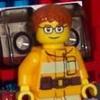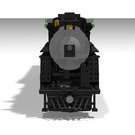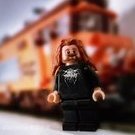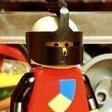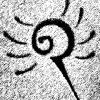Search the Community
Showing results for tags 'Train'.
Found 774 results
-
I'd built a tunnel segment many years ago. It was a small setup that fit onto a single 32x32 baseplate. As my layout expanded, the tunnel looked small, and out of place. I started expanding it, and then the project snowballed. As my layout is never the same between shows, and the hassle of trying to transport it became evident, I had to think about its future. Thusly, I made it into a modular design. Most tunnel segments are on a 32x32 baseplate with an 8x32 baseplate extension on the front. One segment is built on 16-wide to allow for optimization of space depending on the layout and how much room I'm allowed. Here is the full tunnel with all segments I have built. With the exceptions of the ends (and the 16-wide segment, more below), they can be placed in any order. The cabin portal. Two tracks with 8 studs between them. Supports are designed for a 10-wide opening. It is 13 bricks high from the top of the rail to the start of the arches. As seen here, the Disney locomotive fits (barely) width wise, while an intermodal double stack well car makes it through as well height wise. Side view of the cabin portal segment. The 16-wide spacer segment. This one is designed to be butted against the cabin for the woodpile, but could go elsewhere if required. The woodpile can quickly be removed and a tree or other foliage added. The mountain segment. Side view of the mountain segment. The hiking path tunnel goes completely through as well, with a one stud offset. Additionally, you can see the support structure. Note the technic bricks spanning the top and the two down at the bottom. These features are included in all of the segments. That allows me to insert technic pins to the bottom bricks, and anywhere along the top to provide a firm connection between segments. I also put a few plates on the top to hold them together too. As you can see, there is a back plate to all the segments, making them more visually acceptable at shows. The waterfall segment. The expanded waterfall segment. Note the wind turbine on the rocks. Three tunnel segments have points for these. I've only built a pair of turbines though. The 16x32 baseplate at the base of the waterfall expands the scene to show the base. With the removal of a plate, it has an outlet for the river as well. The castle segment. Not visible is the draw bridge leading up to the front entrance and a hidden side exit through the rocks on the right side. In winter, this becomes a double black diamond ski slope. It also has a wind turbine support area. The forest portal segment. It is the final segment with a wind turbine option. The forest portal opening. There you have it, the modular tunnel and all segments I've currently constructed. Did you find the ruby eyed face?
-
First, some context: Here's a shout-out to Daedalus304 and his ATSF #2926 4-8-4 locomotive, for this locomotive of my own shares quite a lot of cosmetics with 2926. Onto my project: Santa Fe 3463 was built on October 30th, 1937 for the Santa Fe Railway as a passenger locomotive and was assigned to crack passenger trains that ran from Chicago, IL to La Junta, Colorado along with its sister locomotives. 3463 was assigned to lightweight trains such as the Chief when they first rolled out, but given their power, they were assigned to heavier trains on the Chicago-La Junta Division in January of 1938. This locomotive pulled trains like the aforementioned Chief, the Scout, The Oil Flyer, and even the Fast Mail Express. In fact, one of these 3460 class Hudsons', No. 3461 set a record for the longest run without any maintenance stops, the only exceptions of course were fuel and water. No. 3460 was given a very special streamline shrouding which earned it the nickname "The Blue Goose" and was the ONLY streamlined locomotive to run on Santa Fe rails. 3463 would soldier on until 1953 when it pulled its last train The Antelope. In 1956, it was put on display outside what is called the Stormont Vail Event Center in Topeka, Kansas, and has remained since. There was an attempt to get this locomotive restored by the CSR in 2012, however, legal issues plagued this for 5 years and after that, the favor was to go to the CSR in 2018. But even then, there were more turn of events that still render the locomotive dormant. To me, the poor girl's restoration was doomed from the start and personally, I would like to see her back in operation someday. This model demonstrates the Hudson in 1/35th scale, it is roughly 11-12 studs wide, approximately 17 studs tall and 113 studs long. This thing is LOADED with details, even an (almost) perfect valve gear system. 6 L-motors are the current power source in place, 2 in the locomotive to keep the drive wheels in order and 4 in the tender, this may be upgraded later but I doubt it. This train HAS been assembled before, however, it was HEAVILY flawed. Faulty drive design with the side rods and gear ratio, too small drive wheels of the incorrect design (I ordered #13 boxpok drivers a while back) which as far as design goes to the wheels, drivetrain, and cosmetics has been resolved. You can check out my wheel by searching for Baldwin Disk Driver. That very same driver will also be going on this locomotive in the future. I even went ahead and designed some special parts that will be incorporated into the locomotive as well. This locomotive is a design that dates back to October of 2021 and by spring of 2023, I plan to have it completed by then unless something comes up. Who knows, I may enter it into the Brick Train Awards if the timing is right and I may have a consist running by the summer of 2023 as well, but I cannot say for certain because the locomotive and tender will come first. For the most part it is complete, but still could probably use a few tweaks before being finalized. With that out of the way, here is the photo gallery of my engine. Here is the valve gear on the LEFT side of the locomotive Here is the valve gear on the RIGHT side of the locomotive I did my best to capture the cab. Unfortunately, I could only find ONE picture and the picture in question is the one with the locomotive in its current condition, that being derelict. Here, we have a water glass on the left, In-Cab signals in the middle, Steam pressure gauge is located below the signals, Speedometer is to the right of the firebox followed immediately after the throttle. The brakes are located below followed by the power reverse on the cab floor. Oil "stoker" is located under the water glass along with gauges.
-
Hi! I just finished the last MOC of this year. I made a total of 41 MOCs in 2022. It was a productive year. I wanted to make an Abandoned Theme diorama/layout/Module that matches the quality of the LLMTC folks. It was the first time that I use MILS, it consumes a lot of non-visible parts, but it allowed me to set up this 1x0,75 meters layout in less than 5 minutes. I tried to make it as realistic as possible, it's based on some buildings/rail way in my country Portugal. I have no clue how many parts I use on this :P
-
https://ideas.lego.com/projects/8cd93420-171c-4ae2-b5a2-0c9d7bbd7412 Hi, please check out my new entry for LEGO IDEAS. I mixed up my latest DB E94/194 version with the coloursceme of one of the greatest LEGO locos. If you like my rendition please support my idea and check out my other entry: https://ideas.lego.com/projects/5c87154b-3396-4343-ac5e-42a5f10bd988 DB BR 194 LEGO IDEAS 4551 SIMON JAKOBI #01 by Simon Jakobi, auf Flickr
-

LEGO RC Trains (not PowerFunctions) IR protocol explained
roeltrain posted a topic in LEGO Train Tech
Hello LEGO Trainenthousiasts, I've made a PowerFunctions-IRcontroller for 4 trains + lights + 3 railswitches with servo's based on an Arduino Uno R3 : https://forum.arduin...?topic=369292.0 One of demands was also using the older LEGO RC-trains. But on the internet no information was found. So with aid of a logicanalyzer I proudly presents the outcome of this investigation: An experiment to make this functional: http://forum.arduino...?topic=320405.0 LEGO RC TRAINS PROTOCOL note: mu s means micro seconds channel 4 means combichannel 1+2+3 This is not the LEGO PowerFunctions IR protocol version 1.20 as described at http://www.philohome...ons_RC_v120.pdf This protocol described below is the predecessor of LEGO PF. Start = Stop is bitstream 36kHz with 10 bits and pauze 1930 mu s Uno is bitstream 36kHz with 10 bits and pauze 280 mu s Zero is bitstream 36kHz with 10 bits and pauze 844 mu s 1 bit has a duty-cycle 16 mu s high and 11,5 mu s low pauze (common factor 18 ms, so factors for Channel actie bitstreams blok-pauze-blok-pauze-blok-pauze-blok) 1 up Start 1111 1111 1110 0001 Stop 3+2+2 = bitstream1 pauze = 3*18ms bitstream2 pauze = 2*18ms bitstream3 pauze = 3*18ms bitstream4 1000 0111 1111 1110 1001 1000 4+5+3 1 down Start 1111 1111 1101 0010 Stop 2+2+3 Start 0111 1111 1101 1010 Stop 3+2+3 1 stop Start 0111 1111 1111 1000 Stop 3+2+2 Start 1111 1111 1111 0000 Stop -------- 1 horn Start 1111 1111 1100 0011 Stop -------- Start 0111 1111 1100 1011 Stop -------- 2 up Start 1110 1111 1110 0010 Stop 2+3+5 Start 0110 1111 1110 1010 Stop -------- 2 down Start 1110 1111 1101 0011 Stop 5+3+3 Start 0110 1111 1101 1011 Stop -------- 2 stop Start 1110 1111 1111 0001 Stop 5+4+4 Start 0110 1111 1111 1001 Stop -------- 2 horn Start 1110 1111 1100 0100 Stop -------- Start 0110 1111 1100 1100 Stop -------- 3 up Start 1101 1111 1110 0011 Stop 5+4+2 Start 0101 1111 1110 1011 Stop -------- 3 down Start 1101 1111 1101 0100 Stop 3+2+2 Start 0101 1111 1101 1100 Stop -------- 3 stop Start 1101 1111 1111 0010 Stop 5+4+5 Start 0101 1111 1111 1010 Stop -------- 3 horn Start 1101 1111 1100 0101 Stop -------- Start 0101 1111 1100 1101 Stop -------- 4 up Start 1100 1111 1110 0100 Stop 2+3+5 Start 0100 1111 1110 1100 Stop -------- 4 down Start 1100 1111 1110 0101 Stop 3+2+3 Start 0100 1111 1110 1101 Stop -------- 4 stop Start 0100 1111 1111 1011 Stop 3+2+3 Start 1100 1111 1111 0011 Stop 2+3+3 4 horn Start 1100 1111 1100 0110 Stop -------- Start 0100 1111 1100 1110 Stop -------- (STOP- button keeps repeating when hold, all others (UP, DOWN, HORN) send only once a message 1e nibble: bit1 bit2 bit3 bit4 Kanaal 1 toggle 1 1 1 Kanaal 2 toggle 1 1 0 Kanaal 3 toggle 1 0 1 Kanaal 4 toggle 1 0 0 2e nibble 1 1 1 1 bit1 bit2 bit3 bit4 3e nibble 1 1 Up 1 0 Down 0 1 Stop 1 1 Horn 1 0 4e nibble toggle ? ? ? (checksum ???) Togglebit reverse from 1st nibble bit1 Any additions/suggestions? I like them- 10 replies
-
- train
- powerfunctions
-
(and 1 more)
Tagged with:
-
Bulk Material Train Unloading Facility features: TRACK 1: Single Car Rotary Dump (Tipper) with electric drive, servo adjustable slip wall for various width cars, mechanically automated clamps that self adjust for various height cars, wheel clamps, car vibrators. Electric Cable Drive Car Indexer with adjustable cable tension. Works with metal axle, standard size wheel cars. Electric drive, jam proof apron feeder and conveyor belts. TRACK 2: Bottom Discharge Bridge with directional discharge chute.
- 21 replies
-
- lego rotary dump
- lego train
- (and 10 more)
-
This green 1930's streamlined caboose was inspired by a very similar real-world Wabash caboose (Katy didn't own streamlined cars like this as far as I know) located on the Katy Rail-Trail at St. Charles, Missouri. The caboose model is also inspired build-wise by the Katy Caboose (as in, "The Caboose who got Loose" from the children's book) model I copied in late 2021 from @zephyr1934's MOC, The one shown later in this post is my own version of that caboose, which you can read about in it's own topic here, or you can see his original version in his own topic. I was going to put MKT (standing for Missouri - Kansas - Texas Railroad, the same owner of Katy caboose, and from where she gets her name) on the sides of the new caboose where the printed brick is but in printed 1 x 1 tile letters, but the needed green 1 x 4 Technic bricks were problematic, as was the two letter T's that I don't have. Also, the doors to the inside open, but there are no interior details. There are a number of similarities between the two caboose models. However, they are more different than alike for several reasons. For example, Katy has A LOT more SNOT-work compared to her newer cousin. Why, you ask? Katy's walls are all sideways to better represent planks of wood (typical in caboose construction up until early-1910's), whereas her opposite number has only SNOT in the base of the body / stairs and regular bricks everywhere else to represent more modern steel construction. (I also left the mouth and eyes off the new arrival.) Thoughts anyone?
-
Technic ans Scale models at Bricking Bavaria 2022
functionalTechnic posted a topic in LEGO Technic, Mindstorms, Model Team and Scale Modeling
Hi everyone Last weekend the Bricking Bavaria 2022 took place in Fürth, Germany. LEGO builders from around Europe travelled to Fürth to show their models. This year large cranes, lang heavy load transporters and even a technic locomotive in scale 1:17 were shown. It was really inspiring to meet other builders and learn about their building techniques, concepts and how their model work. For all people who had not the possibility to come to BB22 I cut a video with as many models in action as possible.- 20 replies
-
- lego
- lego technic
- (and 14 more)
-
Hello. This week I received the another 12v train set that purchased at eBay. My collection has grown a lot in these year and half, so I'd like to share it all in this post [MOC/MOD] 12v Train Collection by Kento Tanaka, on Flickr It all started with this #7865 I bought at BrickLink to build this steam locomotive. [MOC/MOD] 12v Train Collection by Kento Tanaka, on Flickr This little tank engine is my first 12v train MOC. Coloring is based on the blue locomotive in the Torben Plagporg's prototype. (in the photo with large scale trains on the bottom row, it was in the upper left) Inspired by the #7727 and #7730 locomotives, I mixed the two together. [MOC/MOD] 12v Train Collection by Kento Tanaka, on Flickr BR Class 08 MOC made with the second motor I got. 12v system with easy rod installation was perfect for this popular diesel shunter. This build is an entry for the Brick Train Awards 2022. [MOC/MOD] 12v Train Collection by Kento Tanaka, on Flickr There is a connecter behind these two MOCs. [MOC/MOD] 12v Train Collection by Kento Tanaka, on Flickr The connector work together #7821 with 9v motor. [MOC/MOD] 12v Train Collection by Kento Tanaka, on Flickr When I didn't have 12v tracks, I saw @AlmightyArjen's video (https://youtu.be/JjK31O5h1Hc) and learned that 12v motor could run on the 9v track already had. Luckily I have a broken 9v motor so decided to take it out and use it as a power supply. I seldom run it on 9v track now, but I'm keeping it in case I ever use it to power for lights etc. [MOC/MOD] 12v Train Collection by Kento Tanaka, on Flickr This electronic locomotive is based on @HoMa's build. [MOC/MOD] 12v Train Collection by Kento Tanaka, on Flickr Made with an old type 12v motor. [MOC/MOD] 12v Train Collection by Kento Tanaka, on Flickr I already posted about this Köf Ⅱ ([MOC] LEGO Group's Köf Ⅱ - LEGO Train Tech - Eurobricks Forums) using 12v technic motor, so check it out here. [MOC/MOD] 12v Train Collection by Kento Tanaka, on Flickr [MOC/MOD] 12v Train Collection by Kento Tanaka, on Flickr [MOC/MOD] 12v Train Collection by Kento Tanaka, on Flickr [MOC/MOD] 12v Train Collection by Kento Tanaka, on Flickr Each of these small locomotives pulls a set or modified wagons. My favorite is the three #7816 reproduced using shell printed bricks [MOC] 12v Steam Locomotive by Kento Tanaka, on Flickr There is a post about this (https://www.eurobricks.com/forum/index.php?/forums/topic/192393-moc-12v-steam-locomotive/) as well as Köf Ⅱ. [MOC/MOD] 12v Train Collection by Kento Tanaka, on Flickr I recently built two carriages for this locomotive based on @HoMa's Silberlinge. BR 23 which was used as reference for making this MOC, was also modified as Wendezüge after the end of 60's, and actually pulled Silberlinge. I thought these carriages would suit it well. [MOC/MOD] 12v Train Collection by Kento Tanaka, on Flickr The one with yellow line is 1st class and there are private compartments. In the real, there are 2nd class seats in same car but there is no space, so I divided them. LEGO Eisenbahnwelt written by Holger Matthes by Kento Tanaka, on Flickr Instructions for Silberlinge with a steering post can be found in the LEGO Eisenbahnwelt released in November 2022. I made by looking at this book, but the pearl light gray grill bricks and old dark gray curve slopes are very expensive, so I replaced it with the light gray and dark bluish gray respectively. [MOC] 12v Crocodile Engine by Kento Tanaka, on Flickr There is a post about this. (https://www.eurobricks.com/forum/index.php?/forums/topic/192590-moc-12v-crocodile-engine/) I want to build dark green SBB carriages for this engine someday. [MOC/MOD] 12v Train Collection by Kento Tanaka, on Flickr Below is a collection of sets. However, I don't own most of original sets, and in many cases I bought parts from BrickLink and build them from scratch. Depending on the availability of parts, I changing the assembly method and enjoying modifying it, so there are many differences from original set. In #7725, I've added a seat the space behind the weight on the first car. [MOC/MOD] 12v Train Collection by Kento Tanaka, on Flickr And gangway connection for all cars. Also, by making the middle wheel of the dummy motor slidable using 2×4 tile it will run more smoothly. These modifications apply to all my builds. [MOC/MOD] 12v Train Collection by Kento Tanaka, on Flickr #7740 is my most favorite 12v train set. I thought it would be difficult to get the red weights in good condition, so I put black one inside the engine. [MOC/MOD] 12v Train Collection by Kento Tanaka, on Flickr Dining car already exists in #7745, so I wanted to make something different. That's why I installed the bar counter shown in the picture. Manager making cocktails The only secret using yellowed macaronis in place that can't be seen from outside. [MOC/MOD] 12v Train Collection by Kento Tanaka, on Flickr #7745 is the 12v train set that arrived this week as mentioned at the beginning. This high speed train from Germany is in very good condition and runs well. [MOC/MOD] 12v Train Collection by Kento Tanaka, on Flickr The kitchen of the dining car has been remodeled. I felt that the 2×4 light gray brick in the original set weren't enough. [MOC/MOD] 12v Train Collection by Kento Tanaka, on Flickr Lined up the old and new TGV. You can see the evolution of parts in 28 years. Thalys PBA is a PF train MOC with a modified coloring of #10233 and 2 studs longer base. However, I think the actual model is Sud-Est, not Thalys. Very well done for 80's build with no orange parts and limited variety. [MOC/MOD] 12v Train Collection by Kento Tanaka, on Flickr #7755 is a diesel locomotive of shape commonly found in Europe. I changed the step from normal plate to modified plate with bar. [MOC/MOD] 12v Train Collection by Kento Tanaka, on Flickr Black weights are installed inside for the same reason as #7740 above. Engineer can no longer stand up, so I put a gray seat instead. [MOC/MOD] 12v Train Collection by Kento Tanaka, on Flickr In #7820, I changed the 6×6 slopes of the roof because some original 3×4 slopes are yellowed, sparse and doesn't look good. [MOC/MOD] 12v Train Collection by Kento Tanaka, on Flickr The luggage inside has changed greatly from two pallets and yellow desk. There are many letters in the yellow box. (maybe carrying BrickLink orders... ) I'd like at least one more #7820. That's all for my 12v train collection. I also have two-lap of oval tracks and #7856 to 59, two each of #7860 and #7864. It's been a very long post, but thank you for reading to the end.
-
4-10-4 type steam locomotive "Red Demon" + Pan-American Limited - real world train MOC
Murdoch17 posted a topic in LEGO Train Tech
The 4-10-4 (four leading, ten driving, four trailing) "Rainhill" wheel arrangement was so named after the Rainhill Trials of October 1829 in Rainhill, England of which the famous Rocket was the only entrant to complete the Trials. The Rainhill type was designed in 1927 and built in early 1928, though it was originally called the "Gigantic" type, but the planned Centenary of Steam celebration sealed the deal on the naming of the type. (Unfortunately, the plans for the potential celebration were postponed in July 1928 and finally cancelled one day before the Stock Market Crash of 1929.) The steam locomotive prototype of the 4-10-4 Rainhill type was painted a dark red and gray color-scheme with a light gay box on the tender and was sold by Baldwin Locomotive Works in 1928 to Brick Railway Systems, but due to technical teething troubles and because of it's unusual color scheme was nicknamed the Red Demon. The engine worked the trans-continental route on the "pan-American Limited" passenger train from New York to Los Angeles, with the Red Devil or one of it's type worked the portion west from St. Louis to Las Vegas. The Red Demon original engine (number 7957) worked this route from 1930 until being bumped to freight duties in early 1958. The engine then worked freights with it's thirty-nine brother's in diminishing numbers until this one was sidelined in 1971, the last of it's kind. The Red Demon was pulled out of the mothballs in 1973 for potential use on the 1976 American Bicentennial train but politics intervened and Texas and Pacific 2-10-4 number 610 got the job instead. After that, the engine's future looked bleak until the "Save the Red Demon 7957" Committee was formed which raised enough money to restore the engine to working order by 1978 and has kept the engine indoors and in tip-top shape ever since under the Red Demon Incorporated moniker. This company uses five former Brick Railway Systems-styled coaches on fan trips, but they are wholly owned by Red Demon Inc. The tender features the name of the railroad (Brick Railway Systems) on it's side, with a light at the rear and a ladder to the top deck. In reality, there was no 4-10-4 type of steam locomotive. It was strangely skipped over in the age of steam... none of this wheel arrangement were ever built. The name Red Demon was chosen because the 4-14-4 type of Soviet Russia was the closest analogy to my loco... except mine works fine, while the Russian one never did much as it spread the track, ruined switches and pulled the freight cars' couplings apart due to it's raw power. The second reason for the name is the Red Devil, a heavily modified South African 4-8-4 engine with a gas producing combustion system and many modern improvements. That cape gauge engine worked beautifully, but was mothballed in 2003. As of 2018, however, the Red Devil is again puling fan trip trains in South Africa! The three regular coaches, all in the same color scheme as the engine. The Pan-American Limited's observation car. The whole train. Comments, Questions, Complaints, and Suggestions for the future are always welcome! EDIT: 12/8/22: There really is a prototype for everything! I designed a 4-10-4 steam locomotive in 2019, thinking it was a complete work of fiction, as no class had been built to that wheel arrangement. Turns out, I was partially wrong - no class had been built, but one had been designed by Baldwin Locomotive Works, as seen in their online archives! It was a three-cylinder beast drawn up for a road called The Monon (otherwise known as the Chicago, Indianapolis, and Louisville Railroad) back in 1928 - not very far off my fictionalized backstory year of 1927 as written by me in 2019.... spooky, right?- 18 replies
-
- steam
- observation
-
(and 8 more)
Tagged with:
-
Hi all, I was quite pleased with the Lego city 2022 line-up of sets, so I decided to sell some older sets and buy a lot of 2022 sets. By doing so, I also "refresh" my Lego collection. Together with the new train sets, I decided to build a 2022 Lego city and shoot a video of it. Enjoy!
-
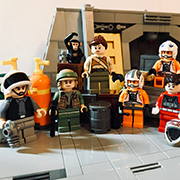
[MOC/MOD] June's Cargo Train. (10219 in Friends Style)
legolux1973 posted a topic in LEGO Train Tech
Hello to the group. My daughter June complained about no trains in the Friends Series, so I tried to redesign the set 10219: Maersk Train (for me as a Noob in Trains one of the train sets I like the most) in LEGO Friends Style and Colors. The main structure of the objects remained the same, major changes were a) the interior of the locomotive cabine so that a friends figure fits in, b) the extension of 1 stud of the truck's cabine (a friends figure can also here sit in now), the front of the locomotive and the layout of the containers. All the parts exist in the corresponding colors, the light bluish grey train base plates are more or less the most "rare" parts. Maybe you like this mod of the 10219: Maersk Train. [MOC] June's Cargo Train by legolux1973, on Flickr Regards, legolux1973 -
I've been split in scale since I began building LEGO trains with all my shunters, freight wagons and latest passenger train being 7-wide or 1:54 and all my older locomotives and passenger wagons being 6-wide or 1:60. With almost all of my buildings close to true minifig-scale, I've been contemplating to unify my scale for a few years now but I couldn't decide to go for either 7 or 8-wide...in addition to being pretty much satisfied with most of my 6-wide models as they are. Well, no more Presenting my favourite Danish State Railways’ (DSB) locomotive redesigned to 8-wide and digitally rendered in two versions and liveries... DSB Litra MZ The powerful Litra MZ locomotives were built by Swedish Nydquist & Holm AB (Nohab) and Danish subcontractors on license from General Motors. 10 MZ (I) were built from 1967-1969. 20 MZ (III) were built from 1972-1974. 61 in total were built across all four variants (I-IV). Quite a few are still used today by private railway companies either domestic or abroad, in Iran, Norway and Australia. My model of DSB Litra MZ (I): DSB maroon livery used in the 1960/70s with the highly recognizable crown and wing logo on the front. Scale: 1:46 Length: 56 studs from buffer to buffer Width: 8 bricks Bricks: 1.264 Powered: 2 x L-motors, 2 x AAA battery boxes + 2 x SBricks, 1 x AAA battery box + 1 x SBrick/PFx Brick or 2 x BuWizz battery boxes Control: PF with SBrick, PFx Brick or BuWizz Designed: 2020 My older 6-wide version from 2016: https://www.eurobricks.com/forum/index.php?/forums/topic/119474-moc-the-danish-state-railways-dsb-locomotive-litra-mz-i/ All renders are done on the very high setting in Stud.io with all of my own custom decals added in the PartDesigner tool. Upgearing from 20 to 12 teeth with a ratio of 5:3....more speed, less power PF L-motor design with good advice from some of the Brick Train Depot guys. Credit to Duq for coming up with the original idea of using the T-piece. 3-axled bogie: The center wheel will utilize a black hockey puck as a blind driver or a 2 x 2 round tile with open stud and 1 x 1 round tile placed on top on it as the alternative. https://www.bricklink.com/v2/catalog/catalogitem.page?P=47576#T=C My model of DSB Litra MZ (III): DSB "modern" red & black livery used in the 1980s. Scale: 1:46 Length: 56 studs from buffer to buffer Width: 8 bricks Bricks: 1.331 Powered: 2 x L-motors, 2 x AAA battery boxes + 2 x SBricks, 1 x AAA battery box + 1 x SBrick/PFx Brick or 2 x BuWizz battery boxes Control: PF with SBrick, PFx Brick or BuWizz Designed: 2020 My older 6-wide version from 2011 and redesigned in 2015: https://www.eurobricks.com/forum/index.php?/forums/topic/172599-moc-herningværket-vestkraft-is-complete-set-of-locomotives-and-wagons Part of the fun and what set LEGO trains apart from pure model railroading is the inclusion of minifigs, so whenever and whatever I always try to make space for them and also keep on some play features and interiors. The 8-wide body is quite roomy and has a fairly correct interior. 2 x PF L-motors with either 2 x AAA battery boxes + 2 x SBricks, 1 x AAA battery box + 1 x SBrick/PFx Brick or 2 x BuWizz battery boxes can be utilized: Both locomotives with DSB Litra MZ (I) in front of the later version DSB Litra MZ (III) in the background: Technical addendum: For the first time ever I have used technical drawings overlayed with LEGO scaled grids to get the dimensions right or as close to right as possible. The models haven't been built yet but some smaller builds have been used for testing during the design phase. My slightly shorter test train didn’t really like driving through R40 curves, no surprise there Too much length overall and the wheel sets in both ends of the bogies are also pretty far from each other producing some drag. Going through isn't impossible though but rather uneven and a tiny bit struggling, especially with added wagons. There are no problems driving on straight tracks and through larger radii curves. To my surprise however was the finding that the total number of parts were the same or even slightly less than a similar 7-wide model So henceforth, 8-wide it is
-
Hi guys! It's not a secret that I like trains , but probably most of you don't know that "Steam" is my least favorite thing related to trains, I'm more into 70's/80's European Electric stuffHowever, I like abandoned stuff so this was more a decorative thing that I build to be part of my first Lego train module (MILS)Lego bricks are glossy, so it was a huge challenge to choose colors and patterns that simulates rust.The locomotive is a 1:45 scale replica of the 2-8-4 CP 180 series, the Portuguese railway company CP Comboios de Portugal has one model preserved and running on the seasonal "Historico do Douro"
- 20 replies
-
- steam locomotive
- train
-
(and 1 more)
Tagged with:
-
The following five models were originally built by my dad without the aid of Bricklink as it didn't exist yet. Only sets bought in stores or parts packs ordered from LEGO directly were used. (at least at first!) Some of these pictures are also quite old, so please bear with me on them. This old gray tunnel was built in the early 1990's. (I added the tan baseplate and RC tracks when I received it from him as a present.) This grain elevator model was around 1999 / 2000. Like most of his MOCs from that time, he built it before he had a BrickLink account. With this one he never finished it 100%, probably due to having us kids (including me) tearing it down and scattering parts every other weekend while he fixed it during the week. Eventually, he put them up out of reach except for special occasions such as the two weeks bracketing Christmas. This vintage model has been used by our family for layouts at his house at Christmas and other times for a long while, throughout most of my childhood up to 2012 or so when we stopped doing a tree + floor layout. These two finger-hinged doors hold the grain back until it is needed to be loaded. He eventually gifted this model to me about in 2021 because he built the Brick Train Depot version and it is better / bigger by like double in size. I added the conveyor belt and tan baseplates for the bottom, as it fits with the rest of my buildings better. This double track train shed was built before I was even born, in 1989. It was originally single track and used parts using quite a few copies of set 6380 (Emergency Treatment Center) from 1987. The rear of the shed. Around 2003, he rediscovered the model and decided to add a second stall to the engine shed, which he did (using a rather new website called Bricklink) He even added brick built re-railers to in-between the rails. The girder bridge was built in the mid -'90's and features the base-plate from set 6552 (Rocky Retreat) from 1993. The guard rails were added in the mid-2000's. This factory was constructed around the years 2001 - 2004 with parts from several Sand Red supplemental packs available at that time. It does not feature any interior, nor does it have a removable roof. But this thing is built STRONG: you have to really put your weight on it to press the roof together. It has never been determined what this factory made in-universe, though for my own purposes, I pretended it made beverages. What beverages, you ask? Why, Leg O. Brick's Root Beer of course! Thoughts on these five older MOC's?
-
Hello. This is my first post, so let me tell you about my story. When I was elementary school, fascinated 12v trains by watching nickname2002's #7740 speed build video. However, as you know they're not sold in Asia (including Japan where I live), so it was very difficult to get them. I've been wanted them over 10 years, so last year finally started collecting parts from BrickLink and eBay to copying sets and making MOCs. LEGO Group's Köf Ⅱ by Kento Tanaka, on Flickr LEGO Group's Köf Ⅱ by Kento Tanaka, on Flickr This LEGO Group's Köf Ⅱ is the latest MOC. Original locomotive used from 1987 to 2002 at LEGO GmbH in Hohenwestedt, Germany. This is the first 8 studs wide train I made. LEGO Group's Köf Ⅱ by Kento Tanaka, on Flickr This is an updated build of the rendering image I entered in Brick Train Awards 2022. LEGO Group's Köf Ⅱ by Kento Tanaka, on Flickr I watched a video of the 12v Crocodile MOC by @HoMa and impressed with it running with 70's pickups and technic motors. I inspired by it, wanted build a locomotive using same motor. This is what it turned out to be, and lucky it was cheaper than normal pack motor. When I making a 12v train MOC, my concept is to incorporate the latest parts and expand the range of expression while creating a style that is appropriate for the “gray era”. So I use parts from wide range of eras, from 70's printed bricks to modern brackets. This shows the high compatibility of LEGO bricks. The wheels are also appear from the 2006 “RC era” with technic axle hole, but the steps and cab are very low, so they works well without spoiling the visual. But it has 2 drawbacks. First, due to low power of the motor, it's the limit to pull 2 wagons. (couldn't down gear for lack of space!) Second, there is no place for minifigure in the cab due to the wiring from pickups. (so I put only torso and head in the cab) LEGO Group's Köf Ⅱ by Kento Tanaka, on Flickr Lastly, I built 2 #7823 container wagon copies and LEGO containers. I don't think I've actually pulled these wagons, but they looks great and I love them. LEGO Group's Köf Ⅱ by Kento Tanaka, on Flickr The container probably holds a full load of LEGO sets… Thank you for reading to the end.
-
MOC: Railroad Service Wagon; Two railroad technicians are expanding the power network. 01_Railroad_Service_Wagon by Mathijs Bongers, on Flickr 02_Railroad_Service_Wagon by Mathijs Bongers, on Flickr 04_Railroad_Service_Wagon by Mathijs Bongers, on Flickr More on Flickr: https://www.flickr.com/photos/mathijslegofan/albums/72177720302493612 Hope you like it
- 2 replies
-
- legomathijs
- train
-
(and 3 more)
Tagged with:
-
[OcTRAINber 2022 - Moc] - FS Vnx806.200 in 1:87 scale
Paperinik77pk posted a topic in LEGO Train Tech
Hi all!!! Some days ago, back from holidays, I found here on EB that the new OcTRAINber contest has been started earlier!!! Well, I was expecting it in October, so I was a bit "unprepared"!!! Topic is particularly interesting , but it's difficult to immediately figure out what to prepare. I was quite lucky, since during the holidays, I had the the opportunity to spot a special hystoric train on the Ceva-Ormea line, in Piedmont. This line was literally the last one adopting the three-phases alternate current "Italian" system, and was converted to diesel-only in 1973. Therefore, being unusable on the new DC system, all the old locomotives were scrapped, or abandoned...or in one specific case...CONVERTED. Here's a specific page (in Italian - but can be translated by the browser), showing the Ceva Ormea in its electric and diesel era. As you can see,the AC system required two overhead wires. http://www.stagniweb.it/foto6.asp?File=l_aln2&Inizio=26&Righe=10&InizioI=1&RigheI=50&Col=5 Among all the AC locomotives, the FS E.550 was the smallest electric "three-phases" locomotive of the whole lot. A small wonder that allowed to pull trains on the terrible Giovi line, which was a real pain for steam locomotives. The AC system was affordable, easy to use, reliable, and smooth. The only problem was related to the fixed speeds (25,50,75, and the top limit of 100 Km/h) , which declared the end of the AC and the adoption of the still used DC system (started with the glorious E.626) The E.550 is only 9.5 meters long, has 5 axles (central one with plain wheels, the outer axles have a lateral movement of 20mm), so it's a pretty agile locomotive. I sincerely DO NOT KNOW if it has ever been used on the Ceva-Ormea line. Now that we've introduced the E.550, let's forget about it for a moment,and let's move again to the Ceva-Ormea line - to be precise to Ceva Station, which is near to my holidays house. Back in the late 80s, my dad used to travel from Genova to Ceva during summer months, staying in our house for weekends. Therefore, on fridays my mom and me used to wait him at Ceva station. This station has a backyard with some dead tracks, which at the time were full of old stuff and easily accessible, since it was near the car parking. In this yard I could see a lot of things - an old shunter, some wagons, a tender... and THAT thing ! For more info, look here - the first photo is clearly depicting what I used to see back in the days: http://www.stagniweb.it/foto6.asp?File=trifase2&Inizio=27&Righe=10&InizioI=1&RigheI=100&Col=5 At the time I tought it was an old, odd diesel snowplow, resembling me a...slug. Then a very nice man working at the station explained me that it once WAS a locomotive and then it was converted to a dummy unit, needing another locomotive to push it. It's marked as VNX 806.200, and it's basically an E.550 without motor,rods,electrical equipment...and with a big snow plow mounted frontally. It was used to clean the Ceva-Ormea line and was permanently assigned (and parked) in Ceva station. I saw a restored VNX at the Savigliano's museum, but it was another unit (VNX 806.221). The 806.200 is currently parked in another station near Turin (I hope waiting for a full restore). This is what I want to propose this year for OcTRAINber contest, and I can tell you it will be in 1:87 (4-wide) and will be a display only model. There will be also an E.550, so I can show the BEFORE and AFTER together (in a pretty limited space!) See you in the next days!!! Davide- 15 replies
-
- train
- transformation
- (and 17 more)
-
Made some fantasy Streamliner-based ideas of shape and colours from snowpiercer and fallout 4 atomic train (wheelbase-arrangement mostly) 8-stud wide coz it's based on American streamliners and they were BIG On Brickink: https://www.bricklink.com/v3/studio/design.page?idModel=348930
- 8 replies
-
- steamengine
- streamline
-
(and 2 more)
Tagged with:
-
My attempt at a Highspeed bullet train was based on the usage of an aeroplane nose and some minor parts of it. Based on ideas of the Shinkansen 0-series. 1 - engine-passenger (2-second class) 2 - passenger (1 and 2-second class) 3 - diner-car (as some bonus wagon) Link to Bricklink Stud.io preview and download
-
Some trams I made coz was bored [MOC] Tatra T3 6 stud wide with boogies on 4 studs That train is used in my native town in the Tram-Subway system Bricklink: https://www.bricklink.com/v3/studio/design.page?idModel=314099 [MOC] American style-tram 8 stud wide tram based on some designs of oldskool trams -streetcars Briklink: https://www.bricklink.com/v3/studio/design.page?idModel=313633 [MOC] European articulated tram Some ideas and modules for the articulated tram I made based on some real-life models Briklink: https://www.bricklink.com/v3/studio/design.page?idModel=349640
-
*A Lego IDEAS submission* Frankie's Farm by Nick Jackson, on Flickr Welcome to the farm! This is a farm-themed freight train set that features the small diesel engine Shiro-chan. Shiro-chan v2 (front) by Nick Jackson, on Flickr There are three freight cars to transport cargo from the farm to your LEGO town. These are an all-purpose gondola, a tanker car, and a wood-paneled livestock car. Gondola (v2) by Nick Jackson, on Flickr Tank Car by Nick Jackson, on Flickr Stock Car (open) by Nick Jackson, on Flickr The farm consists of a barn with a loft, a mini tractor with a trailer, and a raised goods platform with a crane hoist. Barn Full by Nick Jackson, on Flickr Tractor (front) by Nick Jackson, on Flickr Farm Platform by Nick Jackson, on Flickr In the barn's loft there is a spot where a minifigure can take a quick nap next to the hay! Barn Loft by Nick Jackson, on Flickr Barn Open by Nick Jackson, on Flickr Drive the tractor and trailer to haul crates' worth of goods and supplies between the barn and the platform. The cargo platform has attachment points in the base which allow you to rearrange the ramps and staircase. The barn can also attach to the platform. For minifigures, there are two train operators, three farmhands, and an assortment of farm animals including cows, chickens, dogs and cats. Barn, Tractor, & Minifigs by Nick Jackson, on Flickr I built this digitally via Stud.io, but I have also built Shiro-chan (the engine) in real life. Depending on how the support campaign goes, I will attempt to construct the rest of the set. Not all of the parts exist (yet) in the colors depicted however. Thanks so much for taking some time to look at my project! **UPDATE** 6/28/22 So, I ordered some parts and set about building this in real bricks! I think the set turned out rather well! Can you spot the differences between the renders and the irl build…?
-
Interstellar Zephyr - streamlined diesel with passenger train for space layout
Murdoch17 posted a topic in LEGO Train Tech
The Interstellar Zephyr transports Nexus Force personnel as a very high-speed, high-security ground transport between the northern-most city of St. Nicklaus and north-pole-hugging outpost of Ice Station Odyssey, around 500 miles away. (this all takes places on the ice-bound planet of Beta Polaris, which orbits what we here call the North Star, far away from Earth.) Unlike the slower Earth trains, this Zephyr type of space-train is super-streamlined, and can go up to speeds of up to 110 MPH (135 is the loco's top possible speed) on it's special track, with super-elevated curves and long straight-a-way's over hundreds of miles, all while using Positive Train Control (PTC) on the the mostly double-track mainline, where all vehicle crossings are flyovers and switches virtually non-existent once out of St. Nicklaus city limits. This train runs along with nine other identical versions of this train (10 total trains in all) on the route with up to seven in running order on the route and at least two in the maintenance shed / in emergency backup storage at any one time. You may have noticed the train model is NOT in the original light gray "stainless steel" of the original Pioneer Zephyr on which is was (kind-of) based. The orange and white color scheme is because it's for my Nexus Force theme... to be honest, it's not even really a Zephyr that much anymore. It's more of a mix of the Pioneer Zephyr and several other concepts that began in the 1930's - '50's era, like the dome car. (To call it a hodgepodge would be accurate!) This model features three joined cars, with the power car up front, a coach, diner-dome in the middle, another coach, then the observation lounge at the rear. None of the car's roof sections come off, and their is no interior, to save on costs when this model is built in real life. The repurposed 2014 CITY Arctic logo slope on the rear of the lounge car is a missing print, as are the three dark bluish gray "donut" tiles on the loco unit. (these parts should have a engine fan / rotor print) The train uses only a few magnets to sperate the train in the middle, as having Jacobs bogies throughout with my current storage setup would have been unwise. This also leaves open the possibility for future expansion of a car or two... maybe a dome car could be in the cards somewhere down the line? (Yes, I know no shovel-nose Zephyr ever had domes... but this isn't a normal Zephyr, now is it?) You can see more details on the arctic / space base shown above in this thread in the Sci-Fi forum. Be warned, it needs to be updated with some newer pictures of stuff I designed! Thoughts on this model? EDIT 5/10/22: model completely revised and updated. EDIT #2 5/11/22 Three hundred parts found, 737 left to go on my space Zephyr. (the wrong colored window glass will be popped out an replaced when it's needed) The dome car, is not included in the totals either way as I'm still not sure it would work out to build it... even if I did make it work, I would be buying almost every single part on it. So, basically, it won't even be attempted for a while. Also, I got the shovel-nose built except for two orange slope parts. -
1980's-style Red and Blue passenger train and 4-6-4+4-6-4 (Double Hudson) Garratt steam locomotive
Murdoch17 posted a topic in LEGO Train Tech
The look of this train was partially inspired by several 4.5v and 12v-era sets, such 7715 / 7818 for the color scheme and 7740 along with it's supplemental sets 7815 and 7819 for the general look of the coaches. Some parts of this train (the coaches) have already been built from about five years back, while the loco is still a WIP for now. This steam locomotive was slightly inspired by the Rhodesia Railways "15th class" that was used in what is now Zimbabwe. This 4-6-4+4-6-4 Garratt type was 74-units strong and was built by Beyer-Peacock and Company starting in 1940, and after WWII from 1947 to 1952 in seven total batches. You can read more about this specific loco class on Wikipedia. My LEGO MOC version is 'fueled' by oil, whereas the real-world 15th class was coal fired. This is one of the reasons why I said it was "inspired by" and not an exact duplicate of a 15th class. However, the front unit does features a prototypical streamlined casing, and the rear unit partially does too. This LEGO model can take some serious curves (much more than what's shown above!), but that's what you get for building a Garratt: it's one of this type of locomotive's strengths. This picture just shows off the articulation points of my MOC, but technically it could split a switch* and still work just fine with the front engine on one track and rear unit on a second one! *NOTE: Don't try that with a real-world steam loco! The doors on the cab of the loco are supposed to be the 1980's ones with blue print on the lower half. Another missing print is on the oil tank hatches, while number / letter tiles go on the front and rear units. (The front unit gets the numbers, while the rear section gets the letters saying LLR, which stands for LegoLand Railroad.) This baggage / passenger car is called a combine which is short for "combination". All the doors can open on this train, even the sliding ones shown here. The three passenger coaches are identical in every way. The observation car, the rear-most coach on the train, features a platform for sight seeing. The steam loco is still being parted out using pieces from the previous streamlined electric engine and from parts from my collection. Until it's done this is a WIP thread, but suggestions / comments / questions are always welcome no matter the project stage. Drop your thoughts below! -
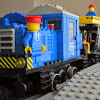
12v trains in alternative colours - looking for some inspiration
exstatik posted a topic in LEGO Train Tech
Hi guys, im looking to build some 12v models in alternative colours. E.g. 7745 in all black or 7755. Looking at Bricklinking cheaper parts. Wondered if anyone had some pictures they may have of stuff they had done for some inspiration? Thanks in advance and I look forward to hopefully seeing some of your creations. ?

